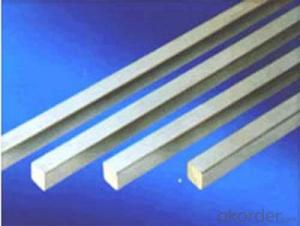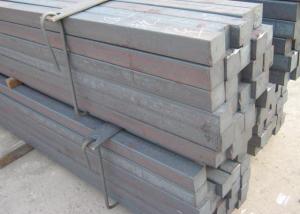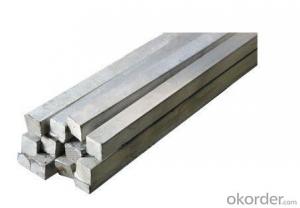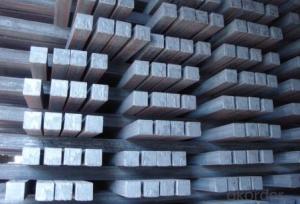Q195B Square bar steel for construction made in China
- Loading Port:
- Tianjin
- Payment Terms:
- TT or LC
- Min Order Qty:
- 10000 m.t.
- Supply Capability:
- 10000 m.t./month
OKorder Service Pledge
OKorder Financial Service
You Might Also Like
Product Description:
OKorder is offering Q195B Square bar steel for construction made in China at great prices with worldwide shipping. Our supplier is a world-class manufacturer of steel, with our products utilized the world over. OKorder annually supplies products to European, North American and Asian markets. We provide quotations within 24 hours of receiving an inquiry and guarantee competitive prices.
Product Applications:
Q195B Square bar steel for construction made in China are ideal for structural applications and are widely used in the construction of buildings and bridges, and the manufacturing, petrochemical, and transportation industries.
Product Advantages:
OKorder's Q195B Square bar steel for construction made in China are durable, strong, and resist corrosion.
Main Product Features:
-Standard: GB,
-Grade: Q195 or equivalent.
-Chemical Composition:
Standard | Grade | Element (%) | ||||
GB | Q195 | C | Mn | S | P | Si |
0.06~0.12 | 0.25~0.50 | ≤0.050 | ≤0.045 | ≤0.30 | ||
Measures of HR Square Bar (small measures):

(Section of HR Square Bar)
-Length of a side and Theoretical weight of Square Bar.
Length of a side(mm) | Theoretical weight(kg/m) | Length of a side(mm) | Theoretical weight(kg/m) |
7 | 0.385 | 22 | 3.80 |
8 | 0.502 | 24 | 4.52 |
9 | 0.636 | 25 | 4.91 |
10 | 0.785 | 26 | 5.30 |
11 | 0.950 | 28 | 6.15 |
12 | 1.13 | 30 | 7.06 |
13 | 1.33 | 32 | 8.04 |
14 | 1.54 | 34 | 9.07 |
15 | 1.77 | 36 | 10.17 |
16 | 2.01 | 38 | 11.24 |
17 | 2.27 | 40 | 12.56 |
18 | 2.54 | 42 | 13.85 |
19 | 2.82 | 45 | 15.90 |
20 | 3.14 | 48 | 18.09 |
21 | 3.46 | 50 | 19.63 |
Notes:
1, The theoretical weights in the list, base on the density of 7.85 g/cm3.
2, Formula for theoretical weight of Square bar: (length of a side)2 * 0.00785
3, The numbers with *mean that they are not regular or we don’t offer them.
-Regular length of Square Bar:
Steel | Length of a side (mm) | Length of steel (m) |
Normal steel | < 25 | 4~10 |
> 25 | 3~9 | |
Steel of high quality | All measure | 2~6 |
Tool steel >75 | 1~6 |
Usage/Applications of HR Square Bar:
-The Square Bar is normally used as structure steel.
-Row material for other structure steel like steel angles, channels, I-beams, H-beams, etc…
Packaging & Delivery of HR Square Bar:
-Packing Detail: The products can be packed in bundles by steel wires.
-Marks: We make tag marks and color marks. The tag marks with white background and red company logo will be tied up to each bundle of the products. The information is usually including basic information of products and company and other information requested by customers. As for color marks, we will paint both ends of bundles to make sure that it will be more convenient for customers to distinguish them from other products.
-Delivery Detail: 30~45 working days after receive buyer’s T.T. or L/C.
Transportation:
-The products can be delivered by bulk vessel or by container. As for container, products with the length of 6m will be loaded in 20’ container, with 9m or 12m, in 40’ container.
-The maximum quantity of loading of container is 25 tons.
-The products are usually transported to the nearest port from the production place.
FAQ:
Q1: How soon can we receive the product after purchase?
A1: Within three days of placing an order, we will begin production. The specific shipping date is dependent upon international and government factors, but is typically 7 to 10 workdays.
Q2: What makes stainless steel stainless?
A2: Stainless steel must contain at least 10.5 % chromium. It is this element that reacts with the oxygen in the air to form a complex chrome-oxide surface layer that is invisible but strong enough to prevent further oxygen from "staining" (rusting) the surface. Higher levels of chromium and the addition of other alloying elements such as nickel and molybdenum enhance this surface layer and improve the corrosion resistance of the stainless material.
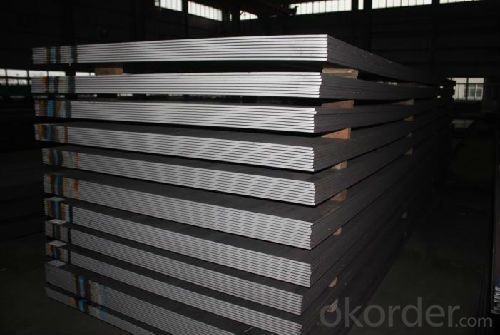
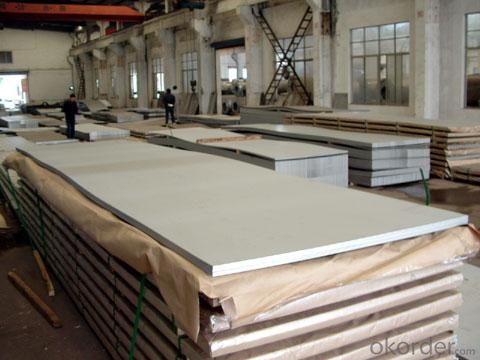
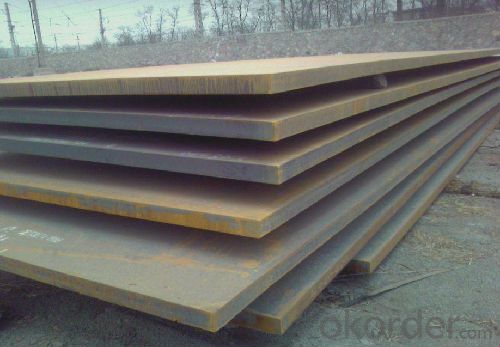
- Q: Can a steel square be used for checking the alignment of walls?
- Yes, a steel square can be used for checking the alignment of walls. The straight edges of the square can be placed against the walls to determine if they are perpendicular or at the desired angle. The square can also be used to check for plumbness by aligning it vertically against the walls.
- Q: How do you use a steel square to measure outside corners?
- Accurate measurements for outside corners can be achieved by following these steps using a steel square: 1. Position the steel square against one side of the corner, ensuring that the long edge of the square aligns with the edge of the corner. 2. Securely hold the steel square, making certain that it is flush against the corner. 3. Observe the measurement on the outer edge of the square where it aligns with the other side of the corner. This measurement indicates the length of the outside corner. 4. If it is necessary to transfer this measurement to another material or surface, utilize a pencil or marker to mark the length on the desired location. By employing a steel square, precise measurements can be obtained for outside corners, guaranteeing accuracy in various construction or woodworking projects.
- Q: How do you use a steel square to determine the rise and run of stairs?
- To use a steel square to determine the rise and run of stairs, follow these steps: 1. Measure the total rise: Start by measuring the total vertical height from the floor where the stairs will start to the floor where they will end. This is known as the total rise. 2. Determine the number of steps: Divide the total rise by the desired height of each step. This will give you the number of steps needed. Round off the number to the nearest whole number and adjust the height of each step accordingly. 3. Calculate the rise: Divide the total rise by the number of steps to determine the rise of each step. This is the vertical distance from one step to the next. 4. Determine the run: To determine the run, which is the horizontal distance covered by each step, use the steel square. Place the square's shorter leg, known as the blade, against the vertical rise line and the longer leg, known as the tongue, against the horizontal floor. Make sure the square is level. 5. Mark the run: Slide the square along the rise line, keeping the blade against the rise and the tongue against the floor. Once the square is aligned with the total run, mark the horizontal line where the tongue intersects with the rise line. Repeat this process for each step. 6. Measure the tread depth: To determine the tread depth, measure the distance from the back of the previous step to the front of the next step. This will give you the horizontal depth covered by each step. By following these steps and using a steel square, you can accurately determine the rise and run of stairs, ensuring a safe and comfortable staircase design.
- Q: What are the advantages of using a steel square over other measuring tools?
- Using a steel square offers several advantages compared to other measuring tools. Firstly, the accuracy and precision of steel squares are well-known. Their design with a right angle and straight edges guarantees highly reliable measurements. This is particularly crucial in construction and carpentry, where precise measurements are essential for project success. Moreover, steel squares are exceptionally durable and long-lasting. Constructed from high-quality steel, they can withstand heavy use and resist wear and tear. This makes them cost-effective, as they don't require frequent replacement. Another benefit of steel squares is their versatility. They can be utilized for various purposes, such as marking and measuring angles, checking edge straightness, and laying out cutting or marking lines. This versatility makes them invaluable for professionals in woodworking, metalworking, and masonry. Furthermore, steel squares often come equipped with additional features like built-in scales and measurement markings. These markings facilitate accurate measurements without the need for extra tools. This saves time and enhances efficiency, making steel squares a practical choice for both professionals and DIY enthusiasts. Lastly, steel squares are relatively compact and easy to carry around. They easily fit in tool belts or toolboxes, making them convenient for on-site use or in tight spaces. This portability aspect adds to their overall practicality and usefulness. In conclusion, the advantages of using a steel square over other measuring tools include its accuracy, durability, versatility, additional features, and portability. These qualities make steel squares indispensable and reliable tools for professionals in various industries.
- Q: How do you use a steel square to check the flatness of a surface?
- To use a steel square to check the flatness of a surface, you'll need a reliable and accurate steel square, which is a tool with a ruler-like blade and a perpendicular handle. Here's a step-by-step guide on how to proceed: 1. Ensure that both the surface you want to check and the steel square are clean and free from any debris or dirt that could affect the accuracy of the measurement. 2. Place the steel square on the surface you want to check, aligning one edge of the square with the surface. 3. Observe the contact between the blade of the steel square and the surface. If the entire length of the blade is in contact with the surface without any gaps or daylight visible, it indicates that the surface is flat. 4. Move the steel square along different areas of the surface, checking for any inconsistencies. If you notice any gaps or daylight between the blade and the surface, it suggests that the surface is not flat in that particular area. 5. Pay attention to the gaps or daylight you observe. If the gaps are consistent in size, it might indicate that the surface has a slight bow or warp. However, if the gaps vary in size, it could suggest a more significant irregularity or unevenness in the surface. 6. Take note of any areas where the surface is not flat. This information can be helpful in determining the extent of the flatness issue and planning necessary corrective measures. Remember, using a steel square is not a foolproof method to measure flatness, especially for large surfaces. It is more suitable for smaller projects or initial assessments. For more precise measurements, specialized tools like straight edges or laser levels may be required.
- Q: How do you use a steel square to determine board footage?
- A steel square can be used to determine board footage by measuring the length and width of a board and multiplying them together to get the total square footage.
- Q: How do you use a steel square to determine the height of a tree?
- To use a steel square to determine the height of a tree, you would need to follow these steps: 1. Stand at a distance from the tree where you can see its top clearly. 2. Hold the steel square vertically, with one edge aligned with the bottom of the tree trunk. 3. While keeping the square vertical, adjust your position until the top edge of the square aligns with the top of the tree. 4. Measure the distance from the bottom of the steel square to the ground, using a tape measure or any measuring tool. 5. This measured distance represents the height of the tree.
- Q: Can a steel square be used for measuring curved surfaces?
- No, a steel square cannot be used for measuring curved surfaces as it is designed for measuring and marking right angles and straight lines.
- Q: What are the different ways to read angles on a steel square when working with metal?
- There are several different ways to read angles on a steel square when working with metal. One way is to use the markings on the square itself, which often include degrees and increments of 45 and 90 degrees. Another method is to use a protractor or angle finder tool, which can provide more precise measurements for more complex angles. Additionally, some steel squares have built-in digital displays or laser guides that allow for even more accurate angle readings.
- Q: Can a steel square be used for measuring the depth of holes?
- Indeed, the depth of holes can be measured with a steel square. By positioning the elongated, straight side of the steel square parallel to the hole's opening, and aligning the perpendicular side with the hole's vertical surface, one can accurately assess the hole's depth. Simply by attentively noting the intersection point between the perpendicular side and the hole's top, the depth can be deduced by examining the markings etched on the steel square.
Send your message to us
Q195B Square bar steel for construction made in China
- Loading Port:
- Tianjin
- Payment Terms:
- TT or LC
- Min Order Qty:
- 10000 m.t.
- Supply Capability:
- 10000 m.t./month
OKorder Service Pledge
OKorder Financial Service
Similar products
Hot products
Hot Searches
Related keywords


